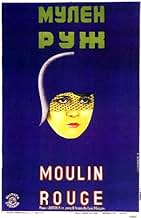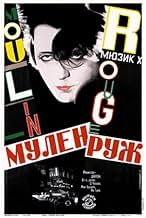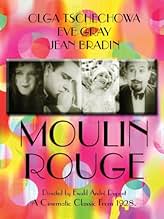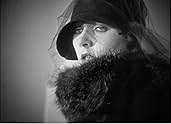Parysia is the rage of Paris. She has a daughter, secretly engaged to Andre, and the boy's aristocratic father objects to the alliance because of Margaret's mother being a revue artist. Dire... Read allParysia is the rage of Paris. She has a daughter, secretly engaged to Andre, and the boy's aristocratic father objects to the alliance because of Margaret's mother being a revue artist. Director Ewald Andre Dupont took almost a year to make Moulin Rouge at a production cost of $5... Read allParysia is the rage of Paris. She has a daughter, secretly engaged to Andre, and the boy's aristocratic father objects to the alliance because of Margaret's mother being a revue artist. Director Ewald Andre Dupont took almost a year to make Moulin Rouge at a production cost of $500,000, a huge amount for 1928.
- Director
- Writer
- All cast & crew
- Production, box office & more at IMDbPro
Featured reviews
The star attraction at the city's most popular hangout is undoubtedly Parysia (Olga Tschechowa), a striking lady who performs to an adoring crowd on a nightly basis, dazzling the audience with songs, dances and shakes of her feathers. She is over the moon when she receives a letter from her daughter Margaret (Eve Gray) announcing her pending arrival. Parysia hasn't seen her child for a few years since she left for boarding school, and she's all grown up with a new man at her side. That man is Andre (Jean Bradin), who believes that he's met the perfect partner until he witnesses his future mother-in-law's stage performance for the first time. Andre falls in love, and declares his feelings to the shocked Parysia, who is determined to see her daughter happy by setting off to persuade Andre's stern, rich father than Margaret is worthy, despite his distaste for the goings-on at the Moulin Rouge.
Dupont's forgotten silent is a strange beast. It is essentially a rather relentless melodrama with little insight into human behaviour, which climaxes with a breathtaking high-speed car chase that would put many modern-day blockbusters to shame. At the film's centre is the odd love triangle between mother, daughter and a handsome charmer, but Dupont ignores the fact that Parysia would realistically want her offspring as far away from this letch as soon as possible once he declares his undying love for the mother of his fiancee. For a movie entitled Moulin Rouge, there's very little of what the venue is best known for, aside from a bit of uncomfortable black-face. From a technical standpoint, it is absolutely wonderful, with the director making full use of his leading star with close-ups and effective camera movements. Tschechowa is a legend of silent cinema, and it isn't difficult to understand why she was courted by the likes of Adolf Hitler and Joseph Stalin. For the most part, this is pretty dull stuff, but the climax will leave you breathless and hugely impressed.
The story involves a love triangle between mother - daughter - prospective son-in-law. The daughter (Eve Gray) never seems to realize that her fiancée has the hots for her own mother. The audience keeps waiting for the light bulb to go off in her head, but she just charges ahead, completely trusting in her mother and young lover, with dangerous consequences.
Olga Tschechowa (a paramour of Adolph Hitler) struck me very much as almost a carbon copy in looks and acting mannerisms to Pola Negri. In fact I kept visualizing Pola in this role as a I watched Olga. Olga was just as good an actress as Pola; every scene she is in your eye gravitates to her first. Effective use of close-ups and intelligent discourse between the characters, reflected in the title cards, adds to the pleasure of this sultry concoction. If you are into romantic foreign silent films this version of Moulin Rouge will prove enjoyable to you.
When the film begins, a famous stage actress from the famed Moulin Rouge is thrilled to have a visit from her daughter. It seems the young lady is planning on getting married and the mother is happy for the couple. However, later when the mother is alone with the girl's fiancé, he suddenly declares his love for the mother! Weird, I know...and where all this goes is a bit far-fetched. It is exciting but kind of silly.
This film brings up lots of problems: why didn't the mother tell her daughter that the boyfriend was a creepy guy and why did the nightclub look NOTHING like anything from the Moulin Rouge (after all, everyone here had lots of clothes)? And, for that matter, why a black-face number?! It all is kind of silly (and a tad offensive) but did have really nice camera-work.
Did you know
- TriviaThe first showings of this film, in 1928, were silent with a live music score by Joseph Littau, In 1929 it was re-issued in a shortened version with a score by John Reynders recorded on an optical track. This contained music and a few (rather primitive) sound effects (as was normal at the time, before dialogue became normal). For the complete restoration at full length the 1929 soundtrack was edited and sections duplicated to fill up the length while matching the music to the action, a process requiring 120 music edits.
- Crazy creditsPersonally directed by E.A. Dupont
- SoundtracksParysia
Music by John Reynders
Lyrics by André Lénéka and Henry Moreau
Performed by Olga Tschechowa, Jean Bradin and Eve Gray
Details
- Runtime2 hours 17 minutes
- Aspect ratio
- 1.33 : 1
Contribute to this page




























